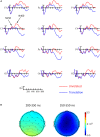An ERP Investigation of L2-L1 Translation Priming in Adult Learners
- PMID: 29971028
- PMCID: PMC6018493
- DOI: 10.3389/fpsyg.2018.00986
An ERP Investigation of L2-L1 Translation Priming in Adult Learners
Abstract
A longstanding debate centers around how beginning adult bilinguals process words in their second language (L2). Do they access the meaning of the L2 words directly or do they first activate the native language (L1) translation equivalents in order to access meaning? To address this question, we used ERPs to investigate how newly learned L2 words influence processing of their L1 translation equivalents. We taught participants the meanings of 80 novel L2 (pseudo)words by presenting them with pictures of familiar objects. After 3 days of learning, participants were tested in a backward translation priming paradigm with a short (140 ms) stimulus onset asynchrony. L1 targets preceded by their L2 translations elicited faster responses and smaller amplitude negativities than the same L1 targets preceded by unrelated L2 words. The bulk of the ERP translation priming effect occurred within the N400 window (350-550 ms), suggesting that the new L2 words were automatically activating their semantic representations. A weaker priming effect in the preceding window (200-350 ms) was found at anterior sites, providing some evidence that the forms of the L1 translation equivalents had also been activated. These results have implications for models of L2 processing at the earliest stages of learning.
Keywords: ERPs; bilingualism; lexical mediation; second language acquisition; semantic mediation; translation priming; word learning.
Figures




References
-
- Altarriba J., Mathis K. M. (1997). Conceptual and lexical development in second language acquisition. J. Mem. Lang. 36 550–568. 10.1006/jmla.1997.2493 - DOI
-
- Brysbaert M., Duyck W. (2010). Is it time to leave behind the Revised Hierarchical Model of bilingual language processing after fifteen years of service? Bilingualism 13 359–371. 10.1017/S1366728909990344 - DOI
Grants and funding
LinkOut - more resources
Full Text Sources
Other Literature Sources

